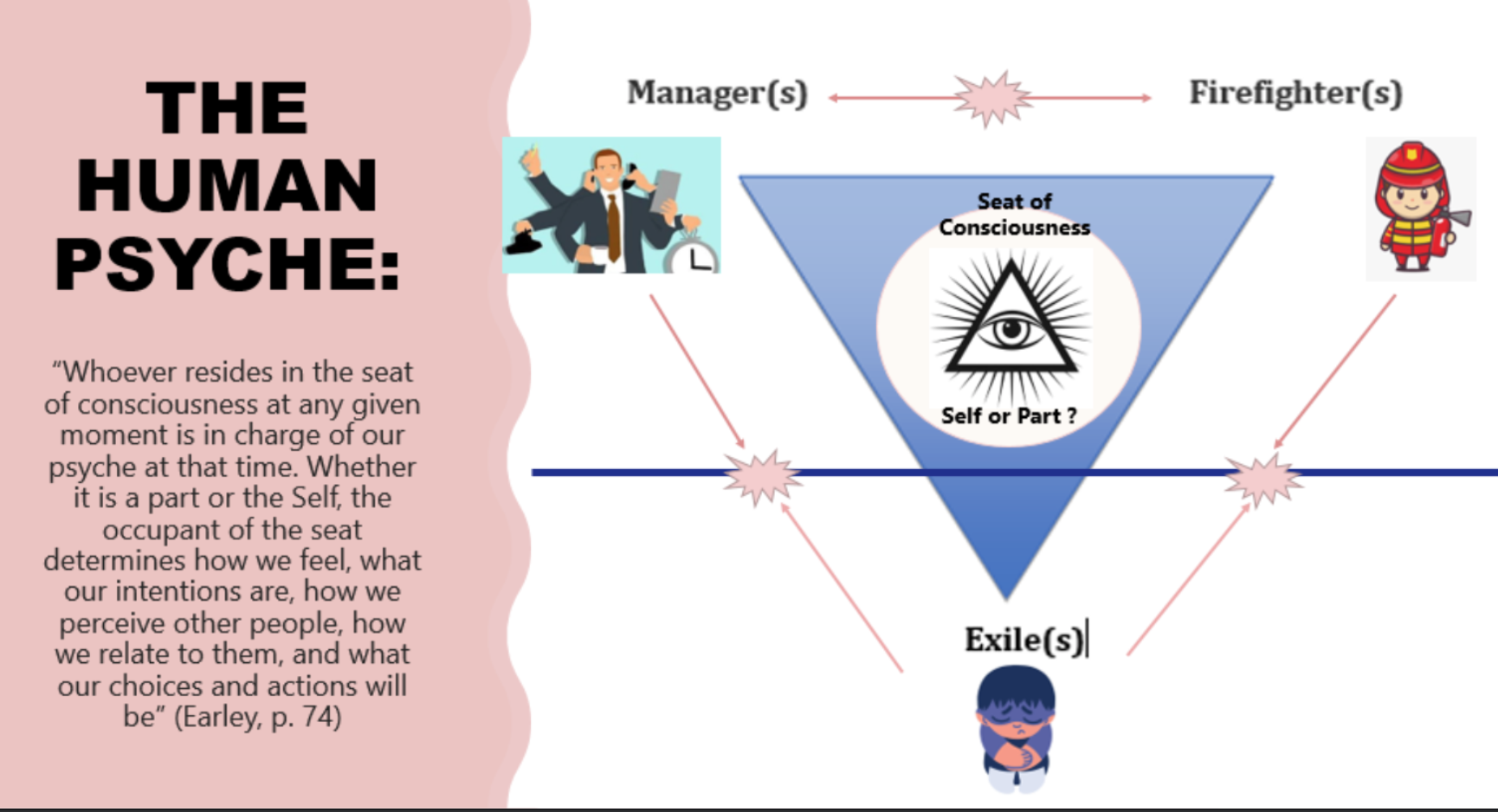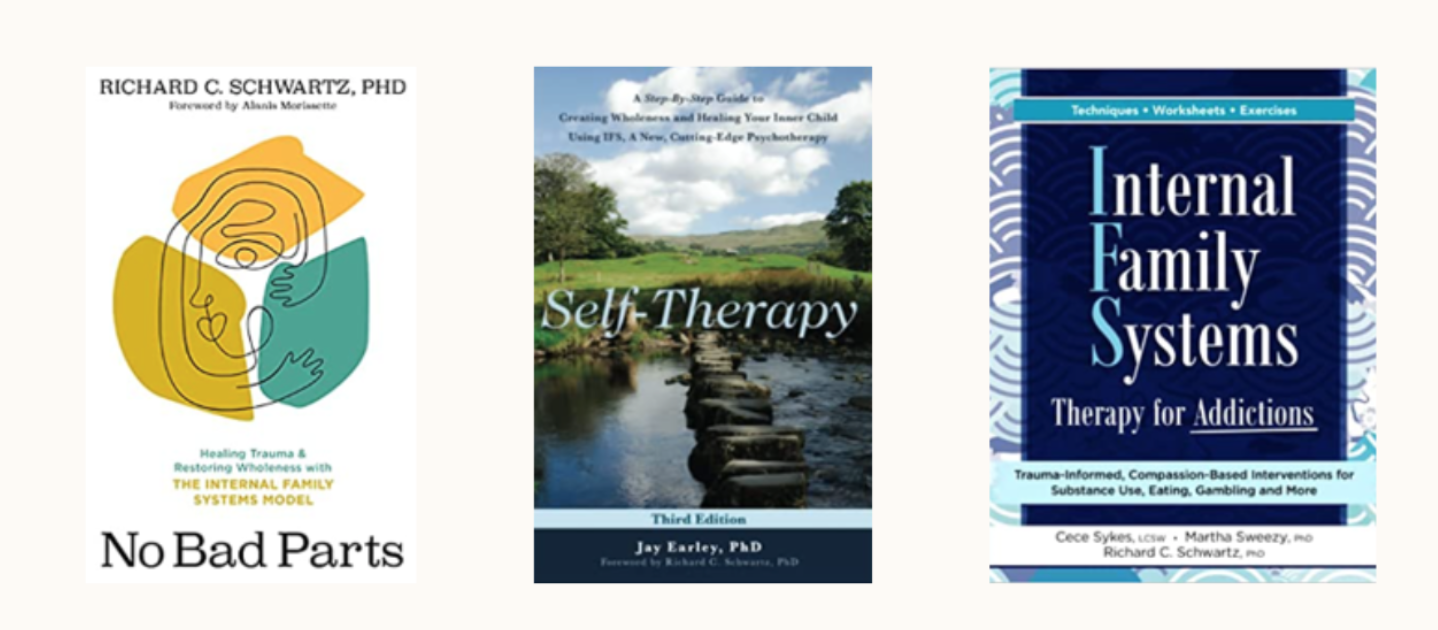In the course of planning a therapy group for veterans with Substance Use Disorders at the Michael E. DeBakey Medical Center in Houston I have gotten to know a lot about an approach to addiction called Internal Family Systems (IFS) Therapy.
The approach was developed by Richard Schwartz, a psychologist and family therapist, and has been tailored to the work with addictions in the new book: Internal Family Systems Therapy for Addictions.
IFS advances a new way of looking at addictions and I think it holds a lot of promise.
In fact IFS introduces a novel approach to working with any kind of “problem” behavior no matter what it is. The approach is currently used to help people with a variety of psychological issues – not just addictions…
In this blog post I will introduce my own interpretation of the Internal Family Systems Model and use the example of someone with an alcohol use disorder to illustrate how it is different from the more prevalent Cognitive Behavioral Therapy (CBT) approaches in the addictions field.
A Traditional CBT Perspective on Addiction
In the traditional view of substance use as an addictive behavior, substance use is considered to be a problem to be eliminated by means of various control strategies.
“The Desire to Use” is pitted against “The Desire to Control”:

On the side of the desire to control we find the whole arsenal of cognitive behavioral strategies that seek to place will power and mind over impulse and emotion.
The person struggling with addictions is told to avoid triggers, ride out the urges (“urge surfing”), use coping skills as replacements for drinking, challenge inaccurate thoughts that lead to strong emotions and the urge to use, deal more skillfully with life’s many challenges, such as using I statements when needing to confront an interpersonal issue, and schedule out activities to reduce idle time.
On the side of the addiction or the desire to use we find all the elements within that we are seeking to eliminate or contain such as the euphoric recall thoughts that remind us of how great it is when we are intoxicated, permission-giving thoughts that provide excuses to use, urges that take over and drive us to use, or emotions and situations (people and places) that trigger us and make us want to use.
The battle is much like any other battle that is produced when will and mind are pitted against impulse and emotion. It produces constant friction or strife between the two opposing sides: the side of me I identify with and that feels like me (the rational and determined part of me) and the part of me that feels like a foreign invader (my addiction as a monster to be slayed). One side is moral and on the side of right. The other is immoral and on the side of wrong.
Addiction from an IFS Perspective:
From an Internal Family Systems perspective the addictive part or the desire to use drugs or alcohol cannot be understood outside of the other parts of my psyche which each play a role in making my substance use necessary.
Here the goal would be to understand the reasons why the impulse to drink gets activated in the first place and to understand what role this impulse plays in relation to the many other different parts of me that make up my psychic system.
From an IFS perspective the causality could look something like the following:
- Negative emotions and memories from my past might overwhelm me sometimes
- When this happens I get an urge to drink to escape or to numb myself
- When I do end up drinking an inner voice gets activated that says I am failure
- This makes me feel worthless and depressed
- To deal with these feelings or shut out the inner critic I take another drink

Looking at addiction this way makes it a functional albeit destructive response to other things going on within me. My impulse to drink is interconnected with the scared and overwhelmed inner child who floods me with memories of traumatic events, the harsh inner critic who tells me I am worthless, and the beaten down depressed self who believes what the critical voice tells it.
According to this perspective, to change the part of me that drinks therefore means to:
- Stop the pain of my scared child from overwhelming me
- Decrease the loudness of my inner critic
- Bolster the worth of my depressed part
To change one element we must change the others…
We can’t just change one element as if it is a “bad tooth” to be plucked (Jung), but must consider the system as a whole to understand the function each part has in maintaining the whole.
Understanding Our Psyche from an Internal Family Systems Perspective:
From an Internal Family Systems perspective the following assumptions are made about our psychic makeup:
- Our psyche consists of many parts
- These parts want different things and sometimes act opposite each other
- Each part serves a particular function within our psyche and often serves to balance each other out or make up for each other’s deficiencies (they each have a role to play)
- Our different parts are parts of an interconnected system, so we can’t just eliminate a part but must understand the role it serves within the system as well as what it is trying to help us with.
- We can treat our different parts just like an inner family where each part has a personality and a role, and has reactions to other parts
IFS is not the only perspective that has ever claimed the psyche is made up of different parts.
This way of thinking is deeply embedded in our culture and our human experience…
- Freud made this assumptions when he divided the mind into: Id, Ego, Superego
- Religions often portray human beings as divided between earthly pleasures and divine virtues (iconically depicted in cartoons as the angel on one shoulder and the devil on the other)
- We often find ourselves speaking in terms of parts: A part me wants to go, another part wants to stay…
Some More Assumptions IFS Makes about Parts:
IFS makes some more assumption about our internal parts:
- Having parts inside does not mean we have multiple personality disorder or are crazy
- Parts inherently have good intentions – even when they mess things up for us (my addictive part that drinks, for example, is not trying to destroy me or destroy my plans, but is trying soothe me and escape from something it perceives to be intolerable)
- Parts become more extreme in their role the greater their perceived sense of danger is or the more extreme other parts become (the more intense and overwhelming feelings were in my childhood the greater the need was to dull my pain by getting rapid relief through drugs; the more I drink to the point of alienating the people I love for example, the stricter my inner critic feels it needs to be to try to reign me in)
- Parts are often childhood parts that had to take on adult burdens and responsibilities prematurely in an effort to help us adapt or survive difficult circumstances (the part of me that drinks could have been relaxing by playing or unwinding but the severity of my emotional overwhelm and the lack of other people to help with the feelings necessitated that it take matters in its own hand and find rapid relief by drinking)
- Parts have restricted vision/ narrow interests (from the perspective of my drinking part I seem helpless to cope and the world seems painful, but when I get in touch with my social part people are great and the world is fun; each part only sees the world through its own narrow perspective)
So What’s the Point?
What are we supposed to do with this awareness of our different parts?
We need to be able to relate to each part – but from an open and compassionate place – not from the judgments and narrow viewpoint of one of our other parts…
Luckily according to IFS…
- We all have an awareness inside that exists over and beyond our different parts
- This “Self” is the consciousness that remains when we step back from each of our parts or ask each part to give us space
- The Self is the spaciousness that remains when we are a pure observer of our inner phenomena – much like when we practice mindfulness
The Self that is Not a Part:

Richard Schwartz, the founder of IFS, writes: “The simple act of getting other parts to open space brings the Self forward, and a lot of meditation works by simply getting you to that more spacious, emptier mind and enabling you to feel the sense of calm well-being that fills that space” – Dick Schwartz: Founder of IFS (No Bad Parts, p. 25)
We can use different metaphors to describe this Self:
- Self as the you that is not a part
- Self as the parent of our many parts
- Self as the conductor of an orchestra
- Self as the “I” in the storm
- Self as a mediator between different parts
- Self as a spaciousness (like the room where the furniture is placed)
- Self as the flashlight of consciousness
When we are in Self we also access certain qualities that are very beneficial. These include the 9 C’s: Calmness, Creativity, Connectedness, Compassion, Confidence, Clarity, Courage, Curiosity, Choice
When we are in Self therefore we have access to a way of being that has a kind of spiritual wisdom, perhaps similar to what Marsha Linehan describes as “Wise Mind”: a locus of attention that is even balanced and can consider input from many perspectives.
Who is In Control: Self or Parts?
At any given moment our seat of consciousness can either be occupied by a part of us or the Self.
As Jay Earley says: “Whoever resides in the seat of consciousness at any given moment is in charge of our psyche at that time. Whether it is a part or the Self, the occupant of the seat determines how we feel, what our intentions are, how we perceive other people, how we relate to them, and what our choices and actions will be” (Self-Therapy, p. 74)

The IFS Mantra: Be in Relation – Not Control
 In their book: Internal Family Systems Therapy for Addiction, Cece Sykes, Martha Sweezy, and Richard Schwarz state:
In their book: Internal Family Systems Therapy for Addiction, Cece Sykes, Martha Sweezy, and Richard Schwarz state:
We don’t ask clients to get in control – we ask clients to get in connection
This of course is what is quite different from the CBT approach described in the beginning.
Instead of prioritizing one part in the system (thinking, planning) over others (emotional, impulsive), IFS asks us to practice stepping into Self so we can relate to each of these parts in a way that makes the parts feel understood and appreciated, and even unburdened from their duties.
The Goal of IFS: Self-Leadership
Since our parts often overfunction due to a perception that it is all on them to make sure we are safe, the introduction of Self can serve to calm our extreme parts and increase their sense that someone capable and wise is in charge. This in turn can make them put down arms, lessen their defenses, and exist within a system that feels safe and organized rather than threatened from many fronts.
This then is what it means to be in connection: To relate from Self to our different parts and have our parts trust that “someone is home”. Or as a client is quoted saying in Martha Sweezy’s book: IFS for Shame and Guilt: “If my parts can feel me, they don’t need to jump on me. If I am able to feel them, they don’t need to fight over who gets felt” (p. 79)
I like to think of Self-leadership as being a good parent to your many parts…

As Jay Earley says in his book Self-Therapy: “Giving respectful, caring attention to our parts permits them to open up deep places inside us—places that can be healed through their relationship with Self” (Earley, p. 49)
An IFS Approach to Addictions:
So where does this leave us in regards to dealing with our addictions? Instead of treating our addictive impulse as the enemy, we can learn to access Self so we can get to know the addictive part from a place of curiosity and compassion. We might then learn what it’s concerns are and what it is trying to do for us and might also learn what other parts of us it is protecting us from. We may for example learn our addictive part seeks to extinguish the feelings of our overwhelmed inner child and can now seek to alleviate these feelings by going back there from a place of Self to help the child metabolize and let go of the difficult feelings no one was there to help them with at the time. We may also listen to the concerns of our inner critic who tells us his harsh voice is needed to keep the destructive consequences of our addictive impulses at bay. By relating to this self-critic from a place of Self we no longer need to be scared or bullied by the voice, but can seek to help the inner critic with its legitimate concerns about order while instilling confidence that this can be done without putting other parts down.
Instead of just focusing on the addictive impulse as if it were a self-contained problem child, we can now cultivate the Self-Leadership needed for all parts of the system to work more harmoniously together and act in less extreme ways. This is what getting in connection rather than getting in control is really about: Building connections to all our parts and making sure all parts are welcome as IFS likes to proclaim. This does not mean that we let our addictive impulse reign destruction on the system by being lenient with it, but that we understand and address the concerns that keep it in its current role, while finding ways to honor its intention without endorsing its methods.
Your Turn to Practice!
Below I have included two guided exercises that will help you get to know more about your parts and help you “unblend” from them so you can get to know them from a place of Self rather than from the judgment of another part.
A. Getting to Know a Part: IFS Worksheet
First practice is a worksheet you can complete that helps you go through 3 steps to get to know a part
Step 1: Find the part: To relate to a part you must first externalize the part by locating it as its own being or entity you can relate to. To do so you can try to identify it through one or more of the following channels: Do you feel it as a physical sensation somewhere in your body? When you think of it does an image come up that represents it? Does it have a name? Does the part exist as an inner voice? Does it make you behave in a certain way? What does the part feel? What does the part want? Once you have used one or more of these channels to identify it, you can move on to step 2
Step 2: How do you feel towards the part? This is the question to assess if you are in Self. If you are in Self the answer to this question will be: curious, compassionate, interested, or some other positive/ neutral quality. If you don’t like the part it means that you are looking at it from the perspective of another part of you and you will therefore first need to ask that new part to step back. Alternatively if you simply feel or speak from the part you are trying to relate to, you are too blended with the part and will need to ask it to step back so you can relate to it from Self.
Step 3: Now that you are in Self you can ask several questions to get to know more about its role, needs, fears, and positive intent. To truly relate to the part means to sense the answers coming from the part and not to put words in the mouth’s part. If you find yourself analyzing the part rather than receiving the answers directly from the part you may have blended with an analytical part and will need to step back into Self. What is called the exile on the worksheet is the part of you that the protective part seeks to keep away from consciousness (it has been exiled or expelled). This exile is often a younger version of you that carries shame, feels pain, or has negative beliefs about themselves or their worth.
Below you can see an example of my own attempt to use the worksheet to get to know a part of me from a place of Self (click on image to enlarge):
Step 1: First I needed to identify a part I wanted to get to know. I had a sense of the part already but wanted to flesh it out a bit to get a better sense of its presence. The part I chose was the “pleaser”, a part of me that is overly apologetic and careful especially in interactions with others. I know this part through its actions of going along with other people even though I sense a resistance inside. It announces itself as a frightened/ anxious feeling. I sense it as a paralysis in the body and a kind of frozenness inside. I also know it as an intention to have minimal impact on others, not wanting to be a burden.
Step 2: At first glance I was a bit annoyed with this part because it seemed weak and spineless. However, I could easily ask that judgmental part to step back and give me room to be curious about my pleaser
Step 3: By being in relation to my pleaser from Self I could ask it more about its role and learn something from it. It seems to protect my freedom and independence by allowing me to not have any relational debts or any guilt, and it also keeps me safe from people’s aggression or dislike. It seems to protect another part of me (an exile) that doesn’t feel interesting enough or important enough to others to be valuable in its own right outside of an exchange of value. I recognize its history as going all the way back to middle school where it stepped in to protect me from bullies when I was at soccer practice and felt I had to agree with another player’s criticism of me as a way to appease the enemy.
As I move on in life I can now start to notice when my pleaser gets activated and see if instead of just automatically letting it take over I can instead recognize it, hear it out, honor my assertive part as well, and evaluate my best course of action from a place of being in Self. I can also use the awareness about my pleaser to try to access the exile it is protecting (the uninteresting self). Gradually as I do this exercise with many different parts of me and keep track of them all I will create more room inside to become the parent to my many parts and get more grounded in my Self.
If I had an addictive part of me I might find that my addictive part drowns out or numbs my emotions of feeling vulnerable or at the mercy of another person’s aggression, whether this be at work with my boss, at home with my partner, or in any other setting where I need to interact with other people. Perhaps the urge to drink could be a part of me that steps in once the pleaser part fails at appeasing, or it might take over as a way to shut down my unworthy exile whose feelings of being unloved and unvalued could break through at any moment. This is how getting to know different parts inside can help inform and inspire compassion for an addictive part who impulsively jumps in to solve a problem in my inner family.
IFS Worksheet: Get to Know a Part
Click on the link below to download a blank copy of the “Get to Know a Part” Worksheet:
B. Getting to Know a Part: Mindfulness Meditation
Another way to get to know a part of you is to do a guided meditation. I have included a script below that combines a script from IFS founder Richard Schwartz with some general mindfulness instructions
Mindfulness Script:

Start by settling into a comfortable position and allow your eyes to close or keep them open with a softened gaze. Begin by taking several long slow deep breaths breathing in fully and exhaling fully. Breathe in through your nose and out through your nose or mouth. Allow your breath to find its own natural rhythm. Bring your full attention to noticing each in-breath as it enters your nostrils, travels down to your lungs and causes your belly to expand. And notice each out-breath as your belly contracts and air moves up through the lungs back up through the nostrils or mouth. Invite your full attention to flow with your breath. Notice how the inhale is different from the exhale. You may experience the air as cool as it enters your nose and warm as you exhale. As you turn more deeply inward, begin to let go of noises around you. If you are distracted by sounds in the room, simply notice them and then bring your intention back to your breath. Simply breathe as you breathe, not striving to change anything about your breath. Don’t try to control your breath in any way. Observe and accept your experience in this moment without judgment, paying attention to each inhale and exhale.
Now become aware of what is going on inside you that seems to grab your attention. Perhaps something happened earlier today that still replays in your mind. Perhaps you are aware of a thought or a concern, maybe about something you need to deal with later or that still feels unresolved for you. You may also be aware of a feeling that is there in the background or perhaps certain sensations in your body that you find it difficult to shake. See if you can get a sense of which of these sensations, feelings, or thoughts most command your attention and you might want to get curious about.
Now as you get a sense of the part you want to get to know more try to see if you can separate from it so you can view it as its own entity, its own little being inside of you, a part of you that you can pay attention to. If you find yourself feeling anything but curiosity toward this part of you, see if you can identify the part that is judging and ask it to step aside. If you notice any resistance from this part that is okay, just make this new part of you the part to get to know.
Whatever the part you are curious about ask it what it wants you to know about it… and just wait for an answer… don’t try to think of the answer, in fact try to ask any thinking parts of you to step away so you can hear directly from the part… and just be patient… until you hear something
Now ask it what it is afraid would happen if it didn’t give you this thought, or feeling, or sensation…. or if it is trying to get your attention because there is something it wants you to know … or that it is hurting somehow
And if at this point you feel like you know something more about it… you might have enough information to extend some appreciation to it… either for protecting you… or for letting you know it is hurting, is scared, or feels ashamed… and if you are able to extend this appreciation, or compassion to it just see how it reacts…
And as the final question in this meditation…. Ask it what it needs from you in the future… what does it need from you in the future?
And sometime in the next minute you can begin to shift your focus back outside… and thank the part for opening up to you and for any other parts of you for giving you the space to get to know it… and let it know this is not your last visit with it… and if this feel complete then slowly come back to the room…
This is an adaptation of a mindfulness video by Richard Schwartz which you can watch here:
Further Resources:
If you would like to read some more about the IFS approach and how to apply it in real life I recommend the following resources:

Richard Schwartz: No Bad Parts (good lay person introduction to IFS from the founder of the approach)
Jay Earley: Self-Therapy (excellent self-help book using IFS)
Sykes, Sweeney & Schwartz: Internal Family Systems Therapy for Addictions (excellent resource for therapists)









